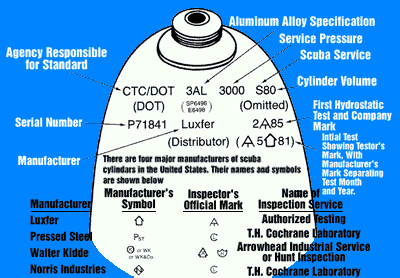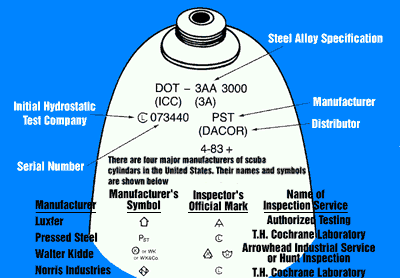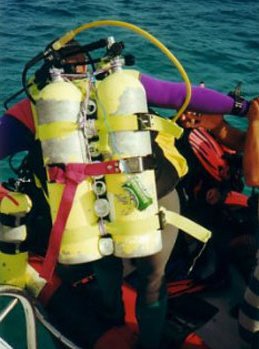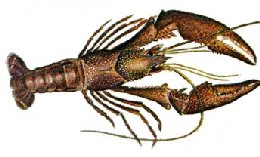Scuba Cylinder Specifications
Here are some dimensions and specifications for scuba cylinders. This is by no means an exhaustive list. These numbers should be taken as approximate since equivalent tanks from different manufacturers will differ slightly. The two most common models - the Catalina aluminum 80 and Luxfer aluminum 80 - are highlighted, along with my favorite, the OMS LP steel 85.
- Weight, full - this is what you will have to be able to lift, in and out of your car, around the dock, and up the boat ladder with all your other gear. Times two for doubles.
- Weight, empty - this is pretty much irrelevant
- Buoyancy, empty - this is what you need to weight yourself for, so that you can do a safe free stop at 20 feet at the end of your dive
- Buoyancy, full - this is what your BC needs to be able to support when you jump in the water, otherwise you are a "dirt dart" heading straight for the bottom and disaster
| Rated Size | Rated Pressure | Dimensions | Weight | Buoyancy + | ||||
| height | diameter | empty | full | empty | full | |||
| cu.ft. | psi | inches | inches | lbs | lbs | lbs | lbs | |
Aluminum: | ||||||||
| Luxfer 63 | 63.0 | 3000 | 21.9 | 7.25 | 26.9 | 31.7 | 2.5 | -2.3 |
| Catalina 80 | 77.4 | 3000 | 25.8 | 7.25 | 31.6 | 37.6 | 4.1 | -1.7 |
| Luxfer 80 | 77.4 | 3000 | 26.1 | 7.25 | 31.7 | 37.4 | 4.4 | -1.4 |
| "Super 80" | 80.0 | 3000 | 22.9 | 8.00 | 35.0 | 40.9 | 2.2 | -3.7 |
| generic 100 | 100.0 | 3300 | 26.2 | 8.00 | 40.8 | 48.2 | 3.5 | -3.9 |
LP Steel: | ||||||||
| OMS* 66 | 66.0 | 2640 | 21.0 | 7.00 | 25.0 | 28.8 | -1.7 | -5.5 |
| Faber 72 | 71.4 | 3000 | 20.5 | 6.84 | 29.0 | 34.4 | -5.9 | -11.3 |
| OMS* 85 | 85.0 | 2640 | 26.0 | 7.00 | 31.0 | 37.7 1 | 0.0 | -6.7 |
| OMS* 98 | 98.0 | 2640 | 24.0 | 8.00 | 38.0 | 45.7 | 0.0 | -7.7 |
| PS** 104 | 104.0 | 2640 | 26.2 | 8.00 | 46.0 | 54.1 | -2.5 | -10.6 |
| OMS* 108 | 108.0 | 2640 | 26.0 | 8.00 | 41.0 | 48.0 | -1.0 | -8.0 |
| PS** 120 | 120.0 | 2640 | 33.0 | 8.00 | 54.0 | 63.5 | 0.0 | -9.5 |
| OMS* 121 | 121.0 | 2640 | 29.0 | 8.00 | 45.0 | 54.5 | 0.0 | -9.5 |
| OMS* 135 | 131.0 | 2640 | 30.7 | 8.00 | 47.0 | 58.1 | 0.8 | -10.3 |
| OMS* 71 | 71..0 | 3440 | 21.3 | 6.75 | 24.7 | 30.1 | -1.4 | -7.0 |
| OMS* 80 | 80.0 | 3440 | 20.9 | 7.25 | 28.6 | 34.7 | -1.7 | -8.1 |
| PS** 80 | 80.0 | 3500 | 19.8 | 7.25 | 27.0 | 31.5 | -1.0 | -5.5 |
| OMS* 100 | 100.0 | 3440 | 25.4 | 7.25 | 34.3 | 41.9 | -0.6 | -8.4 |
| PS** 100 | 100.0 | 3500 | 23.9 | 7.25 | 33.0 | 40.5 | 0.0 | -7.5 |
| OMS* 119 | 119.0 | 3440 | 24.2 | 8.00 | 38.9 | 47.9 | 0.2 | -9.1 |
| PS** 120 | 120.0 | 3500 | 29.0 | 7.25 | 38.0 | 49.0 | 1.0 | -10.0 |
| Aluminum | ||||||||
| Catalina 13 | 13.2 | 3000 | 12.3 | 4.37 | 5.4 | 6.4 | -0.4 | -1.4 |
| Luxfer 20 | 19.9 | 3000 | 21.9 | 4.38 | 8.2 | 9.5 2 | 0.1 | -1.4 |
| Catalina 30 | 30.0 | 3000 | 20.0 | 5.25 | 13.7 | 16.0 | 0.0 | -2.3 |
| Catalina 40 | 40.0 | 3000 | 24.9 | 5.25 | 15.7 | 18.7 | 1.9 | -1.1 |
| Steel | ||||||||
| OMS* 46 | 46.0 | 2640 | 23.0 | 5.50 | 17.6 | 21.6 3 | 0.0 | -4.0 |
| OMS* 20 | 20.0 | 2640 | 19.5 | 3.90 | 7.5 | 9.0 | -1.5 | -3.0 |
Hmm ... | ||||||||
| OMS* 85 | 97.0 | 3000 | 26.0 | 7.00 | 31.0 | 38.4 | 0.0 | -7.4 |
1 with valve, boot, and a good fill - 42 lbs HP Steel: ( DIN valve only )
2 with valve & mounting bracket - 11 lbs
3 with valve, boot, and a good fill - 23 lbs
+ at rated pressure
* Faber** Pressed Steel
density of dry air = 0.076 lb / cu-ft
Weights and buoyancies that I would consider to be excessive are highlighted in red. In particular, the Faber 72 is ridiculously heavy for its size, and excessively negative, and aluminum 80s are far too buoyant when empty.
Notes on the hydro test
The hydro test requires a tank to pass certain dimensional criteria when filled to 5/3 of its rated pressure. For a low-pressure steel tank, this is 5/3 x 2400 = 4000 psi, which, for an OMS/Faber, is the manufacturer's rated pressure outside the United States. In other words, it is really no test at all, or, you basically can't fail hydro. ( You can still let it rust, though ! ) For an aluminum tank, this is 5/3 x 3000 = 5000 psi, and aluminum tanks fail quite commonly. For a high-pressure steel tank, hydro pressure is 5833 psi. Good luck.


Thanks again to diver Art Greenberg for scrupulously checking these numbers ( even though he's still not quite satisfied with them. )


